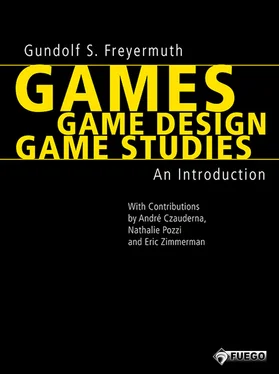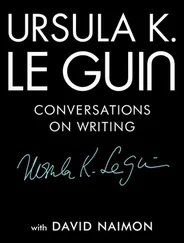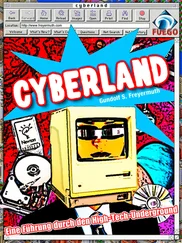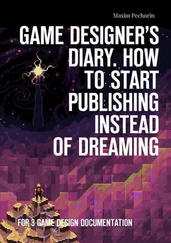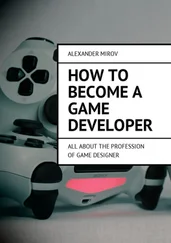Gundolf S. Freyermuth - Games | Game Design | Game Studies
Здесь есть возможность читать онлайн «Gundolf S. Freyermuth - Games | Game Design | Game Studies» — ознакомительный отрывок электронной книги совершенно бесплатно, а после прочтения отрывка купить полную версию. В некоторых случаях можно слушать аудио, скачать через торрент в формате fb2 и присутствует краткое содержание. Жанр: unrecognised, на английском языке. Описание произведения, (предисловие) а так же отзывы посетителей доступны на портале библиотеки ЛибКат.
- Название:Games
- Автор:
- Жанр:
- Год:неизвестен
- ISBN:нет данных
- Рейтинг книги:4 / 5. Голосов: 1
-
Избранное:Добавить в избранное
- Отзывы:
-
Ваша оценка:
- 80
- 1
- 2
- 3
- 4
- 5
Games: краткое содержание, описание и аннотация
Предлагаем к чтению аннотацию, описание, краткое содержание или предисловие (зависит от того, что написал сам автор книги «Games»). Если вы не нашли необходимую информацию о книге — напишите в комментариях, мы постараемся отыскать её.
Addressing these fundamental questions and aspects of digital game culture in a holistic way for the first time, Gundolf S. Freyermuth's introduction outlines the media-historical development phases of analog and digital games, the history and artistic practices of game design, as well as the history, academic approaches, and most important research topics of game studies.
Games — читать онлайн ознакомительный отрывок
Ниже представлен текст книги, разбитый по страницам. Система сохранения места последней прочитанной страницы, позволяет с удобством читать онлайн бесплатно книгу «Games», без необходимости каждый раз заново искать на чём Вы остановились. Поставьте закладку, и сможете в любой момент перейти на страницу, на которой закончили чтение.
Интервал:
Закладка:
From a media historical perspective, therefore, quaternary mediality 37, i.e., the transition to the digital transmedium and its multichannel communication, directly influences the production as well as the reception of audiovisions. For one, it initiates a fusing of the creative authority that characterizes the manual production of imagery with the qualities of industrial reproduction. From the 1970s through the 1980s the technical and aesthetic development of hyperrealistic audiovisuality occurred primarily in the context of the—American—motion picture industry and on the technical basis of pre-rendering. However, since the 1990s, game engines have been realizing the potential of quaternary mediality for the real-time generation of virtual images and sounds—in nearly ‘photorealistic’, i.e., lifelike quality. 38
Secondly, the integration and drastic escalation of reception methods associated with primary, secondary, and tertiary mediality were attained on the side of the receivers or users. In virtuality, it is possible for the first time to almost arbitrarily choose and switch between other-determined, self-determined, and interactive use of medial artifacts. Thereby it appears that the digital transmedium is ushering in a historical turnaround, or perhaps a reversal, to a mode of thinking in regard to the culturally dominant behavior towards aesthetic artifacts.
The sweeping immobilization of the audience—in the theater, the museum, the movie theater, in front of radio and television—was, as is generally known, an achievement of industrial culture. Until late in the 19th century, for example, theater auditoriums were not darkened. Contemporary illustrations and descriptions document to what degree the audience, who could see and hear each other and understood attending the theater as a social event, interacted among each other and even with the actors, whether by praising or heckling them. It was Richard Wagner in Bayreuth who first introduced collective tunnel vision from the darkened auditorium toward the stage. For reasons of aesthetic contemplation, his arrangement constituted a proto-cinematic form of reception that the movies would later require for technical reasons.
The early cinema was then also faced with the difficult task of preventing the audience—now mostly from the middle and lower classes—from general uproar and outbursts of dissatisfaction, especially from throwing objects at the actors, i.e., the projection screen, as theater attendees were accustomed to doing at live performances. The obvious connection between what the new industrial media demanded of their audiences, and what the industrial way of life demanded in general, has often been commented on. 39A relatively clear line from the training for physical and communicative passivity combined with the necessity to pay exceptional attention to quickly changing situations in art and entertainment, can be traced to a dual phenomenon: first, the experiences enabled by new transportation methods such as railroad and automobiles; secondly, the challenges of industrial work that relied on standardized, passive behavior that seemed to almost be controlled remotely but had to be, of course, self-controlled.
In contrast, digital knowledge work is characterized by acting independently in the creative, also thoroughly exploratory, and thereby playful, manipulation of software programs and files and their virtual symbols. 40From this perspective it is hardly surprising that at the same rate as empowered knowledge work—especially in the so-called ‘creative industries’—is becoming the most important source of economic growth, so, too, are changes in cultural behavior toward aesthetic artifacts taking shape. Playfulness, which was important in pre-industrial times, was forced by industrialization into the private sphere (and from there expelled to the edges of what was considered high culture)—with some good reason, considering the violence and danger arising from industrial machines and processes. In an attempt to belittle games in comparison to books, Harry Pross wrote: “In the […] sector […] of free-time and incompetence, the game is at home in numerous forms.” 41From there, however, it is returning—in the course of a “movement from a culture of calculation to a culture of simulation” 42—into the center of postindustrial civilization. The contradiction between work-ethic and play-ethic that industrial rationality assumed, and that existed in factories as well as in bureaucracies, is gradually dissipating.
With some consequence the phantasmic secular space, in which digital knowledge workers collect their aesthetic experiences, is no longer to be found in material reality but rather in virtuality. There, the process of dematerializing dislocation that began with the movies comes to completion: where on stage human beings of flesh and blood stand, the cinema projects images of light. Online, spectators and actors alike are now also shedding their corporeality in favor of mediated presences by turning into virtual co-players. In this way games profit from the changing nature of work in digital culture. The readiness to be passively entertained over long periods of time is on the decline, while inversely, the readiness for interactive participation is on the rise. Players see the need for making your own decisions that analog and digital games require not as a burden but rather as a pleasure.
Today we must, therefore, differentiate between games of primary, secondary, tertiary, and quaternary mediality. Games of primary mediality are based on real simulations of reality, those of secondary mediality on symbolic representations of reality, and those of tertiary mediality on tele-auditive or tele-audiovisual participation at real simulations of reality as well as symbolic representations of reality. In contrast, digital games now enable interactive participation not only at virtual, real-time simulations of symbolic representations of reality, but also, most importantly, at virtual, real-time, and hyperrealistic simulations of the imaginary.
Because of these singular medial characteristics, digital games seem to correspond to the experiences of cultural digitalization more fully than other forms of representation and storytelling: digital games relate to the changing ways of perceiving time and space and to new conceptions of how, under the requirements of digital production and communication, humans have to be and act.
The three successive developmental pushes in which the new digital medium gained its current characteristics, between the mid-20th and the start of the 21st century, will be presented in the next three chapters.
1The German noun ‘Spiel’ can mean both game and play (which includes both connotations of ‘play’ as they are found in English usage, i.e., leisure activity and theater); the verb ‘spielen’ can express both the acts of playing as well as acting or performing. So already the German language itself reveals the shared origins and ongoing aesthetic proximity of ‘Spiel’ to the most important variations of audiovisual representation in modern times: from the stage play (Bühnen spiel ) with its subcategories of comedy (Lust spiel ), tragic drama (Trauer spiel ), music play/drama (Sing spiel ) or festival (Fest spiel ) a clear line connects to the moving picture (Licht spiel ), which appeared around 1900 in both of its variations—the fiction film ( Spiel film) and the documentary film, which gave way to the television show (Fernseh spiel ) and the video and computer game (Video spiel and Computer spiel ). Moritz Lazarus remarked already in 1883, “that the etymology of the German word ‘Spiel’ indicates a light, aimlessly floating, self-returning movement, a movement that is not caught in a narrowly focused action and is not directed toward an approaching goal, but rather is concerned with the here and there, and the back and forth between polar positions.” (Cited from Krämer, Sybille: “Ist Schillers Spielkonzept unzeitgemäß? Zum Zusammenhang von Spiel und Differenz in den Briefen ‘Über die ästhetische Erziehung des Menschen’,” in: Bürger, Jan (ed.), Friedrich Schiller: Dichter, Denker, Vor- und Gegenbild, Göttingen: Wallstein-Verl. 2007, pp. 158-171.) Until this day, a widespread connotation of the German word ‘Spiel,’ which has this aimless ‘here and there’ at its core, has to do with a mostly unintentional freedom of movement within and among machine parts: ‘The steering has too much play (“Spiel”).’ This is just how Katie Salen and Eric Zimmerman define human play: “Play is free movement within a more rigid structure.” (Salen/Zimmerman: Rules of Play , loc. 4730) The fact that the most important audiovisual modern media have the same German language ‘last name’ of ‘Spiel’, which has its roots in free motion, points to what binds these media together irrespective of their great variety: the principle of aesthetic play. According to Friedrich Schlegel, aesthetic play also possesses narratological and mimetic features, within which the “appearance of acts” (“Schein von Handlungen”) is generated through artistic means (Athäneums Fragments, in: Schlegel, Friedrich von/Behler, Ernst/Anstett, Jean Jacques/Eichner, Hans: Kritische Friedrich-Schlegel-Ausgabe: Erste Abteilung: Kritische Neuausgabe , vol. 2, Munich; Paderborn; Wien: F. Schöningh 1967, p. 180).—This definition has bestowed validity upon many later attempts—from Johan Huizinga up until contemporary game theorists like Jesse Schell—through the advantage of an openness which transcends the boundaries of the arts (and media). While this definition generally covers the similarities of the stage play (Bühnen spiel ) and the digital game (digitales Spiel ), it inevitably avoids their differences. For the close relationships among audiovisual media say little about the quality of those actual relationships. Cain slew Abel and everyone would like to find their own familial example of the dialectic of attraction and repulsion, of alternating states of cooperation, coexistence, and constant strife. In particular, the various—aesthetic, artistic, practical, technological, economic—aspects of the cultural relationships between game and film demand a more precise, historical clarification. See Intermezzo: Game//Film , p. hereff.
Читать дальшеИнтервал:
Закладка:
Похожие книги на «Games»
Представляем Вашему вниманию похожие книги на «Games» списком для выбора. Мы отобрали схожую по названию и смыслу литературу в надежде предоставить читателям больше вариантов отыскать новые, интересные, ещё непрочитанные произведения.
Обсуждение, отзывы о книге «Games» и просто собственные мнения читателей. Оставьте ваши комментарии, напишите, что Вы думаете о произведении, его смысле или главных героях. Укажите что конкретно понравилось, а что нет, и почему Вы так считаете.
